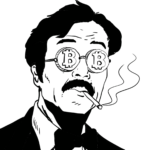A financial indicator indicates an imminent recession
A highly reliable financial indicator, the yield curve has recently inverted. However, Wall Street has always considered this indicator as a harbinger of an imminent recession. Are we going to experience a catastrophic year 2024 economically, which could take down the stock markets and bitcoin (BTC) with it?

An Inversion of the Yield Curve
Many predicted that the money printing policies of the early 2010s would lead to hyperinflation. That the rate hikes of the mid-2010s would result in a recession.
And that COVID would create a new Great Depression, and so on. None of these doomsday predictions have come true. Since around 2012, the US economy has continued to strengthen.
In the world of finance and in financial journalism, many believe it is possible to predict a recession well in advance, using what is called the yield curve.
When there is an “inversion of the yield curve,” a recession is supposed to occur 6 to 12 months later. Historically, this indicator has proven quite reliable.
The last four or five times we have had an inversion of the yield curve, there has been a recession shortly thereafter.
Yield Curve: A Reliable Indicator
In fact, this trend holds especially true if we go back to the 1950s. The only time this indicator resulted in a “false positive” was in 1966. One false positive out of nine is a rather satisfactory track record.
The other main thing you should notice on the graph is that the yield curve inverted very recently. In fact, the inversion occurred in November 2022, over a year ago.
The most commonly used indicator of an imminent recession has therefore been flashing red for some time now.
And in this election year, where the fate of the country might well depend on the economic mood of Americans, the question of whether we are on the verge of a recession is very important.
But it is also true that in the 14 months since the yield curve inversion, we have not yet seen a recession – not even anything close to it.
The Wall Street Journal conducts a monthly survey among economists and, at the start of 2023, the probability of a recession within the year was over 60%. As of this month, that probability has dropped to less than 40%.
What Is the Yield Curve?
When one talks about the “yield curve,” it refers to the difference between long-term interest rates and short-term interest rates on government bonds. Another name for this difference is the “term spread.”
Long-term rates are generally higher than short-term ones. Why is that?
Due to the risk of rising interest rates.
Long-Term Bonds
When you buy a long-term bond – for example, a 10-year bond – your money is not technically locked up for 10 years. If you need money today – if you have a medical emergency or if you get laid off – you can sell your bond on the bond market and get immediate cash.
But how much money can you get? That depends. If interest rates have risen since you bought the bond, the price of your bond will have fallen.
Indeed, when interest rates rise, the price of existing bonds decreases (because investors can now get new bonds that offer a better interest rate, so they value the old bonds less).
In this case, if you have to sell your 10-year bond before its maturity, you will incur a loss. (You can also keep your 10-year bond until maturity and get all your money back… but then you have to keep your money locked up for years, earning what is no longer an attractive interest rate).
Short-Term Bonds
Short-term bonds, on the other hand, have very little of that risk. Short-term bonds lose much less value when interest rates rise – they are short-term, meaning they don’t pay interest for very long.
So their interest rate isn’t as significant to their overall value. Short-term bonds are therefore less risky than long-term bonds.
An Upward-Sloping Yield Curve Under Normal Circumstances
In finance, if something entails a higher risk, it must also offer a higher return, to justify the increased risk.
Therefore, long-term bonds usually pay higher interest rates than short-term bonds, to justify their higher risk. That’s why there’s usually a positive rate spread.
Another way to put it is that “the yield curve is usually upward-sloping.” It’s just another way of saying that long-term interest rates are usually higher than short-term rates.
But this isn’t always the case.
Sometimes, short-term rates are actually higher than long-term rates! In such cases, we talk about an inversion of the yield curve. It means the spread between short-term and long-term rates is negative.
The Factors that Favor an Inversion of the Yield Curve
Fundamentally, it could be anything that raises short-term rates relative to long-term rates. In principle, it could be many things. Here is a list of 3 factors that could differentially affect interest rates:
Expectations Regarding the Real Economy
When the economy starts to grow quickly, rates tend to increase naturally, because the return on investment is simply higher across the board in a good economy.
In a recession, rates naturally tend to decrease, for the same reason. If investors start to become pessimistic about the real economy in five years, they’ll expect short-term rates to go down in five years.
Long-term rates will therefore go down now, because they’re influenced by the expected change in short-term rates. But the short rates don’t go down as much, because the expected recession is still a long way off.
The Fed
The Federal Reserve can raise or lower interest rates through monetary policy, by buying and selling bonds.
Generally, when the economy is doing well, the Fed raises interest rates to avoid or reduce inflation, and when the economy is doing poorly, the Fed lowers interest rates to stimulate the economy.
In the past, the Fed tried to control only short-term rates, but since the era of quantitative easing, it sometimes also controls long-term rates.
But fundamentally, rate increases generally lift short-term rates relative to long-term rates.
Expected Inflation
Remember, when we talk about “interest rates,” what’s usually meant are nominal interest rates.
But what really matters to investors are real interest rates. If investors expect higher inflation, they will demand a higher interest rate for the money they lend, to offset the future inflation they foresee.
If they expect inflation to be high in the short term and lower in the long term, they will demand a higher short-term interest rate but a lower long-term interest rate.
These factors are also not independent. The Fed’s policy affects both the real economy and inflation. The real economy and inflation affect each other and also encourages the Fed to change its policy.
In Short
So let’s put all these factors together and explain simply why inversions of the yield curve are harbingers of recessions.
There’s an economic boom. Short-term rates rise because of the economy’s strength. The strong economy overheats, causing inflation.
Short-term rates rise even more, as people expect the high inflation to continue for some time. The inflation hike prompts the Fed to raise short-term rates in order to slow down inflation.
These three factors – the economy’s vigor, high inflation, and the Fed’s rate hikes – lead to a hike in short-term interest rates. But people expect the economic boom and inflation to subside in a few years, thanks to the Fed’s action.
They also know that once a recession hits, the Fed will cut short-term rates. So long-term rates don’t rise as much, or even decrease. And there we have it, an inversion of the yield curve has occurred.
Why Did the Yield Curve Invert in 2022?
But there’s a big difference between now and the past.
In the 70s and 80s, inflation only subsided during a recession. But in 2023, inflation dropped before any recession actually happened.
We managed to escape inflation before facing the harsh economic devastation of the early 1980s.
It’s possible it’s just a temporary reprieve. It’s possible that high interest rates, exacerbated by the move to remote work, will eventually decimate the commercial real estate market and trigger a new financial crisis and a deep recession.
That we haven’t achieved a soft landing as Jerome Powell predicted, but a delayed reaction. We will see.
Is It Different This Time?
But it’s also possible that this time is different.
It’s possible the Fed has finally found a way to convince America that it’s serious about inflation without wreaking havoc on the real economy. And it’s possible that the lowering of inflation expectations, combined with the drop in oil prices and supply chains, were enough to curb post-pandemic inflation without the need for a Paul Volcker-style demand destruction.
In the face of the recent inversion of the yield curve, the shadow of a recession looms, but the outcome remains uncertain in the current economic context. In any case, these are only speculations and rough theories. We will probably have the answer by the end of 2024.
Maximize your Cointribune experience with our "Read to Earn" program! For every article you read, earn points and access exclusive rewards. Sign up now and start earning benefits.

Chaque jour, j’essaie d’enrichir mes connaissances sur cette révolution qui permettra à l’humanité d’avancer dans sa conquête de liberté.
The views, thoughts, and opinions expressed in this article belong solely to the author, and should not be taken as investment advice. Do your own research before taking any investment decisions.